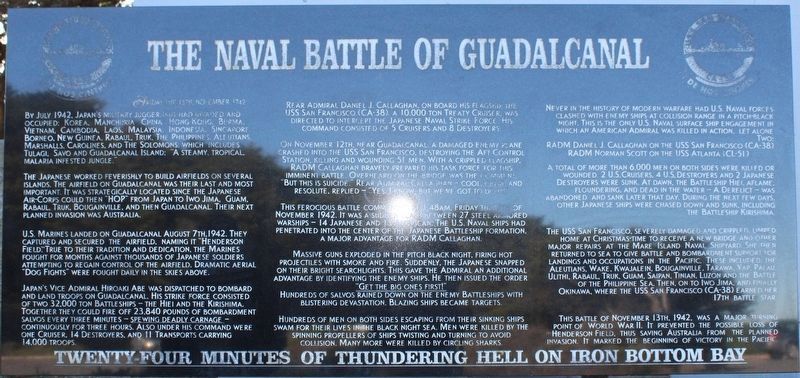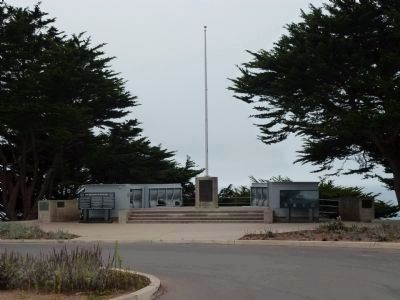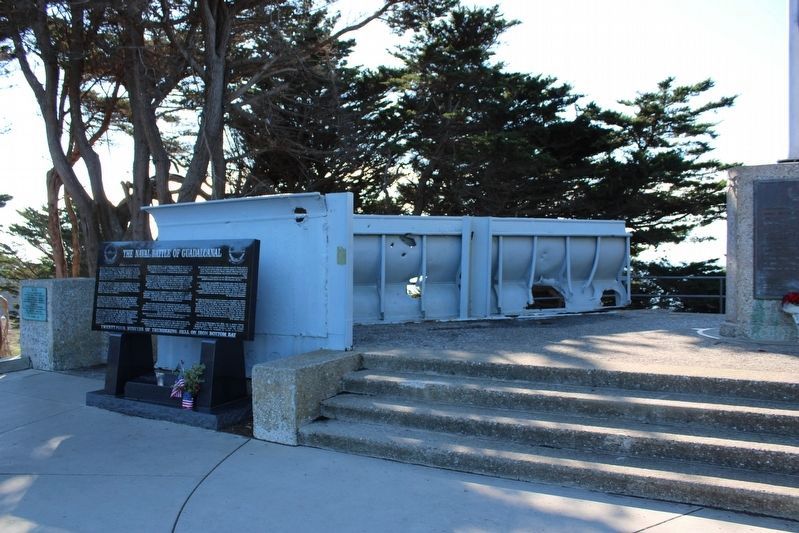Lincoln Park in San Francisco City and County, California — The American West (Pacific Coastal)
The Naval Battle of Guadalcanal
Twenty-Four Minutes of Thundering Hell On Iron Bottom Bay
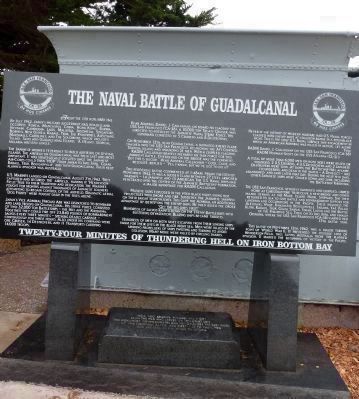
Photographed By Grace C. Miller, October 7, 2012
1. The Naval Battle of Guadalcanal Marker
"These two granite plaques are a gift from the men who served on this great ship [USS San Francisco]. This monument commemorates and memorializes the survivors of the ferocious battle and especially to those who are still at sea, never to return."
Friday the 13th November 1942
By July 1942 Japan’s military juggernaut had invaded and occupied Korea, Manchuria, China, Hong Kong, Burma, Borneo, New Guinea, Rabaul, Truk, The Philippines, Aleutians, Marshalls, Carolines, and the Solomons, which includes Tulagi, Savo and Guadalcanal Island. “A steamy, tropical malaria infested jungle.”
The Japanese worked feverishly to build airfields on several islands. The airfield on Guadalcanal was their last and most important. It was strategically located since the Japanese Air-Corps could then “hop” from Japan to Iwo Jima, Guam, Rabaul, Truk, Bougainville, and then Guadalcanal. Their next planned invasion was Australia.
U.S. Marines landed on Guadalcanal August 7th 1942. They captured and secured the airfield, naming it “Henderson Field”. True to their tradition and dedication, the Marines fought for months against thousands of Japanese soldiers attempting to regain control of the airfield. Dramatic aerial “Dog Fights” were fought daily in the skies above.
Japan’s Vice Admiral Hiroaki Abe was dispatched to bombard and land troops on Guadalcanal. His strike force consisted of two 32,000 ton Battleships—The Hiei and the Kirishima. Together they could fire off 23,840 pounds of bombardment salvos every three minutes - spewing deadly carnage - continuously for three hours. Also under his command were one Cruiser, 14 Destroyers, and 11 Transports carrying 14,000 troops.
Rear Admiral Daniel J. Callaghan, on board his flagship the USS San Francisco (CA-38), a 10,000 ton treaty cruiser, was directed to intercept the Japanese Naval Strike Force. His command consisted of 5 Cruisers and 8 Destroyers.
On November 12th, near Guadalcanal, a damaged enemy plane crashed into the USS San Francisco, destroying the Aft Control Station, killing and wounding 51 men. With a crippled flagship, RADM Callaghan bravely prepared his task force for this imminent battle. Overheard on the bridge was the comment “But this is suicide”. Rear Admiral Callaghan — cool, calm, and resolute, replied —“Yes, I know, but we’ve got to do it!”
This ferocious battle commenced at 1:48AM, Friday the 13th of November 1942. It was a sudden clash between 27 steel armored warships - 14 Japanese and 13 American. The U.S. Naval Ships had penetrated into the center of the Japanese battleship formation, a major advantage for RADM Callaghan.
Massive guns exploded in the pitch black night, firing hot projectiles with smoke and fire. Suddenly, the Japanese snapped on their bright searchlights. This gave the Admiral an additional advantage by identifying the enemy ships. He then issued the order “Get the Big Ones First”. Hundreds of salvos rained down on the enemy battleships with blistering devastation. Blazing ships became targets.
Hundreds of men on both sides escaping from their sinking ships swam for their lives in the black night sea. Men were killed by the spinning propellers of ships twisting and turning to avoid collision. Many more were killed by circling sharks.
Never in the history of modern warfare had U.S. Naval forces clashed with enemy ships at collision range in a pitch black night. This is the only U.S. Naval surface ship engagement in which an American Admiral was killed in action, let alone two: RADM Daniel J. Callaghan of the USS San Francisco (CA-38), RADM Norman Scott on the USS Atlanta (CL-51).
A total of more than 6,000 men on both sides were killed or wounded, 2 US Carriers, 4 US Destroyers and 2 Japanese Destroyers were sunk. At dawn, the Battleship Hiei aflame, floundering, and dead in the water — a derelict — abandoned and sank later that day. During the next few days, other Japanese ships were chased down and sunk, including the Battleship Kirishima.
The USS San Francisco, severely damaged and crippled, limped home at Christmas time to receive a new bridge and other major repairs at the Mare Island Naval Shipyard. She then returned to sea to give battle and bombardment support for landings and occupations in the Pacific. These included:
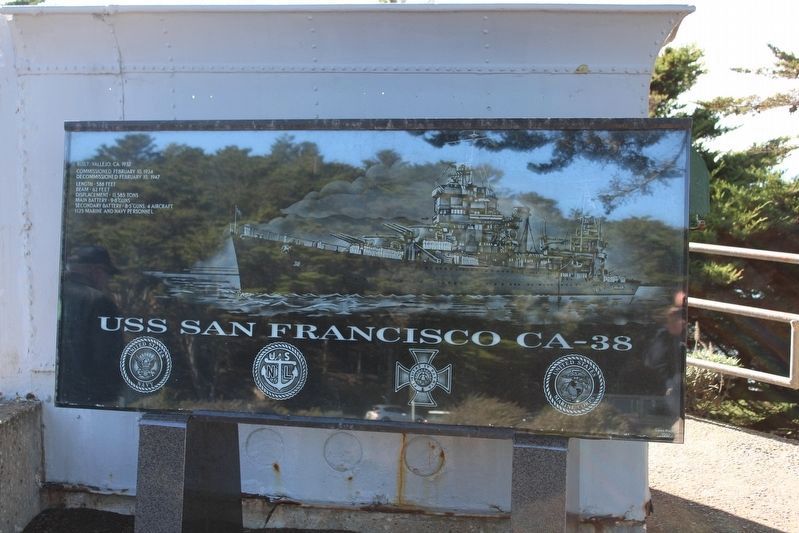
Photographed By Joseph Alvarado, November 14, 2022
3. USS San Francisco CA-58 Plaque
Built: Vallejo, CA. 1932
Commissioned February 10, 1934
Decommissioned February 10, 1947
Length – 588 feet
Beam – 62 feet
Displacement – 11,585 tons
Main Battery – 9-8” guns
Secondary Battery – 8-5” guns: 4 aircraft
1125 Marine and Navy personnel
Commissioned February 10, 1934
Decommissioned February 10, 1947
Length – 588 feet
Beam – 62 feet
Displacement – 11,585 tons
Main Battery – 9-8” guns
Secondary Battery – 8-5” guns: 4 aircraft
1125 Marine and Navy personnel
This battle on November 13th 1942, was a major turning point of World War II. It prevented the possible loss of Henderson Field, thus saving Australia from the planned invasion. It marked the beginning of victory in the Pacific.
Erected by USS San Francisco Memorial Foundation.
Topics. This memorial is listed in this topic list: War, World II. A significant historical month for this entry is July 1942.
Location. 37° 46.967′ N, 122° 30.69′ W. Marker is in San Francisco, California, in San Francisco City and County. It is in Lincoln Park. Memorial is on El Camino del Mar north of Sea Rock Drive, on the left when traveling north. Touch for map. Marker is at or near this postal address: 2586 El Camino del Mar, San Francisco CA 94121, United States of America. Touch for directions.
Other nearby markers. At least 8 other markers are within walking distance of this marker. FDR's Salute (here, next to this marker); This Memorial to Rear Admiral Daniel J. Callaghan (here, next to this marker); The Honored Dead (here, next to this marker); Death of a Sailor (a few steps from this marker); Lands End (within

Photographed By Joseph Alvarado, November 14, 2022
4. Below the First Marker
These two granite plaques are a gift from the men who served on this great ship. This monument commemorates and memorializes the survivors of this ferocious battle and especially to those men who are still at sea, never to return.
More about this marker. The Memorial is located at Fort Miley, a unit of the Golden Gate National Recreation Area-Lands End.
Related marker. Click here for another marker that is related to this marker. To better understand the relationship, study each marker in the order shown.
Also see . . . Second Naval Battle of Guadalcanal: Turning Point in the Pacific War. U.S. Task Force 64 (including battleships Washington and South Dakota) finish off the IJN forces on 14-15 November 1942 - under VAdm. Willis Augustus "Ching" Lee, Jr. (Submitted on October 29, 2012, by Richard E. Miller of Oxon Hill, Maryland.)
Credits. This page was last revised on February 7, 2023. It was originally submitted on October 2, 2012, by Don Morfe of Baltimore, Maryland. This page has been viewed 1,387 times since then and 43 times this year. Last updated on July 20, 2014, by Richard E. Miller of Oxon Hill, Maryland. Photos: 1. submitted on November 3, 2012, by Richard E. Miller of Oxon Hill, Maryland. 2, 3, 4. submitted on November 26, 2022, by Joseph Alvarado of Livermore, California. 5. submitted on October 8, 2012, by Richard E. Miller of Oxon Hill, Maryland. 6. submitted on November 26, 2022, by Joseph Alvarado of Livermore, California. • Bill Pfingsten was the editor who published this page.
